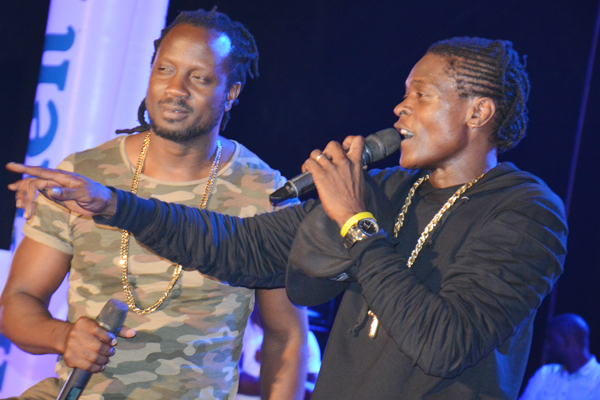Singer Geoffrey Kyagambiddwa alias Chagga, says one of the factors that influenced Jose Chameleone to relocate to Nairobi where he felt he could launch his music career back in the early 2000s, was Bebe Cool’s stardom in Kenya.
Chameleone who then went by the name Raggaman Jose had been doing karaoke (mostly ragga) in hangouts in Kampala, until he thought it was time to try his luck in Nairobi.
He had opened up for a Kenyan music group – Kalamashaka – at Sabrina’s Pub in Kampala and later that evening got a contact for one of the members.
Kalamashaka first came into the limelight in 1997 with their hit single Tafsiri Hii which was released two years after they had come on the Kenyan music scene. The members Kama, Roba and Johnny were childhood friends from Dandora, a Nairobi suburb.
“He (Chameleone) got a telephone number of one of the group members. He then tells me he is going to move to Nairobi because that’s where the future is. I tell him ‘I won’t come with you because I know nobody in Nairobi’. The initial plan was to move together but when I returned home and thought through it, I chose not to,” Chagga who for long sang as Chameleone’s backup in Leone Island, said in a recent interview with Ibra Mukasa.
“The time Chameleone went to Nairobi, he found when Bebe Cool had already been a star there. Bebe Cool was the main reason Chameleone got the urge to leave Uganda,” he adds.
He recounted a day he and Chameleone were at the National Theatre only to read an article in one of the Kenyan dailies where Cool was being praised.
“We saw in the Kenyan papers a story that was praising Ugandan artiste Bebe Cool who had become a sensation there (in Kenya). Bebe Cool got a full page, I remember he was wearing a red leather jacket. Chameleone asked me ‘How does this guy do it? I’m sure I can outdo him’. It must have been a Daily Nation newspaper but that article threw us off.”
It was a guy named Adam Keita that made Chameleone’s trip to Nairobi possible, according to Chagga. Keita had a link in the Mawingo buses that plied Kampala – Nairobi back then. Chagga says Keita bought Chameleone a stool where he sat in the Mawingo bus corridor since he couldn’t afford the bus fare.
Chameleone has hinted on this story in his 2010 song Vumilia.
“Kuingia hi game it wasn’t kazi ndogo. It was the time in Nairobi na kitu kidongo. Transportation yes me went with a Mawingo. Seated on a stool in a bus corridor,” one of his verses in the song goes.

When Keita died in 2014, Chameleone described him as a comrade with whom they had come a long way. The two had met back at Nakasero Primary School where they became friends.
“You introduced me to the streets and promoted me to Nairobi as a hustler on the Mawingo bus. I returned as a brother and we together planned the ‘Jamila’ video in which your face will remain for life even when you gone” Chameleone eulogized Keita in 2014.

In the same song, he pays homage to Gagamel, Redsan and Ogopa Deejays the studio in Nairobi where Chameleone and Bebe Cool recorded their initial songs.
Bebe Cool (formerly Bebe Bunton) had left Kampala earlier, in 1997 immediately after completing his S6 exams at Kololo S.S. And while at Ogopa Deejays, he recorded songs like King of the Jungle (his first song), Fitina and Mambo Mingi. He was among the very first artistes to be affiliated to Ogopa Deejays.
In a previous interview, Cool has stated that Chameleone rang him before moving to Nairobi and that the two met at Afya Centre on the latter’s arrival.
“I was shocked when Redsan told me Chameleone had called. Beacause i knew Chameleone as (my) fan. When I performed at Ecstacy in Banda, he always came with his small bike and waited to offer me a ride home at night. It was his strategy to get close to me the star,” Cool has boastfully said previously.
According to Chagga’s account, Chameleone made about three trips to Nairobi with no success until he could finally find his ground. Each time he returned, there were lessons and he knew what his next plan would be.
“The first time he went, he didn’t have a passport. He ran into trouble with the Police in Kenya. So, he returned and we had to devise means so he could get the documents. And he got the passport. That man is a hustler. He’s very aggressive,” Chagga revealed.
Chameleone’s arrival in Kenya is about the same time Cool who was then working with Redsan forms the East African Bashment Crew. In years that follow, Chameleone moves from the studio where the two stayed. He begins to live with his white girlfriend, Dorotia whom he had met there.
In Nairobi, Chameleone put together his first and second albums.
He had been spending much time at Ogopa Deejays which molded his first skills in audio production. These skills would come in handy when he returned home. Ogopa had also produced his very first single Bageya (which featured Redsan) off the first album Bageya in 2000.
There were times Chagga escorted him to Nairobi to back him up during his studio sessions. While on later occasions, after Chameleone had set up his own studio in Kampala, he sent Chagga to have some of his work mastered at Ogopa.
Bei Kali, Njo Karibu and Mambo Bado were some of such projects.
His single Mama Mia off his second album under the same name, is what amplified Chameleone’s popularity back in Uganda and set him on a new course musically.
Inevitably, he and Cool parted ways, owing to the friction that had grown out of competition and Chameleone continued working with Redsan until he returned to Kampala to promote Mama Mia. At the time, Shanks Vivie D, Ragga Dee, Afrigo Band, Ragga Boys and Red Banton were some of the already established names in Kampala.
“We took the song to a bar called Chaos which was opposite Garden City. DJ Alex Ndawula was playing. He played the song many times and he endorsed. He told us about a party that was set to happen at Capital FM and asked Chameleone to perform this song,” Chagga said in the interview.

“All I can say is, when he performed the song at the party, everything changed. His life has never been the same. All the headlines that followed were about his performance at that party. ‘Mama Mia’ blew up.”
With the Mama Mia sensation also came bookings for shows, some of which Chagga recalls were in Lira, Gulu and Arua. Being the newbie he was, Chameleone had no car so they took a bus.
“Imagine, we were in a taxi heading to Arua, we bought a newspaper where Chameleone featured on front page, but we read the story discreetly because we didn’t want the passengers in the taxi to know the guy in the news was the same guy being squeezed in a taxi,” he said.
Many years later, Chameleone and Cool have each consolidated their wins from Nairobi. Ogopa Deejays which pioneered Kenya’s first urban sound helped them establish their identity that would later inspire the Afropop sound in Uganda.
On return, they also each set up their own stable – Leone Island and Gagamel – through which they would churn out dozens of albums and several records that have had them dominate the Ugandan music scene for two decades.
Part of the journey has also been characterized by fights, a continuation of what Cool calls healthy competition (beef) that began as far back as their days in Nairobi during which they even fought physically.








